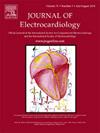Electrocardiographic LVH criteria: Poor diagnostic accuracy even with optimized cutoffs. Insights from MESA study
IF 1.2
4区 医学
Q3 CARDIAC & CARDIOVASCULAR SYSTEMS
引用次数: 0
Abstract
Background
Electrocardiographic (ECG) “left ventricular hypertrophy (LVH) criteria” are widely used as surrogates for increased LV mass but show limited sensitivity. We evaluated their diagnostic performance against cardiac magnetic resonance (CMR) in a large population cohort.
Methods
We analyzed 4849 participants from the Multi-Ethnic Study of Atherosclerosis (MESA) with standardized digital 12‑lead ECGs and CMR-derived LV mass indexed to body surface area (LVMi). LVH was defined as LVMi >91 g/m2 (men) and > 77 g/m2 (women). We assessed Sokolow-Lyon, Cornell voltage, Cornell product, Peguero–Lo Presti, Sokolow-aVL, and MESA-LVH (SV1 + SV2 + RV5). Diagnostic accuracy was calculated for classic (“pre-specified”) thresholds and for cutoffs optimized by the Youden index. We also tested whether combining indices via elastic-net penalized logistic regression improved discrimination.
Results
LVH prevalence was 30.2 %. Across classic thresholds, sensitivities were very low (3.7–15.2 %) with high specificities (>94 %); likelihood ratios were modest (typical LR+ <4; LR− ≈ 0.89–0.96). Youden-optimized cutoffs improved sensitivity (48.9–64.8 %) at the expense of specificity (54.4–74.3 %), yielding weak LR+ (1.42–1.94) and LR− (0.64–0.71). Pooled area under the ROC curve (AUC) for individual indices ranged 0.62–0.66. An elastic-net model combining all indices did not enhance discrimination beyond the best single measure (AUC 0.646).
Conclusions
In MESA, ECG voltage criteria—whether applied at classic or optimized thresholds—show poor diagnostic performance for CMR-defined LVH. Aggregating indices provides no material gain. These findings support reframing voltage positivity as an amplitude-based electrical phenotype with prognostic value rather than a reliable diagnostic surrogate for structural hypertrophy.
Clinical trial registration
ClinicalTrials.gov Identifier NCT00005487.
心电图LVH标准:即使使用优化的截止值,诊断准确性也较差。来自MESA研究的见解。
背景:心电图(ECG)“左室肥厚(LVH)标准”被广泛用作左室重量增加的替代指标,但其敏感性有限。我们在一个大型人群队列中评估了它们对心脏磁共振(CMR)的诊断性能。方法:我们分析了4849名来自多民族动脉粥样硬化研究(MESA)的参与者,使用标准化的数字12导联心电图和cmr衍生的左室质量与体表面积(LVMi)指数。LVH的定义为LVMi >91 g/m2(男性)和> 77 g/m2(女性)。我们评估了Sokolow-Lyon、Cornell voltage、Cornell product、Peguero-Lo Presti、Sokolow-aVL和MESA-LVH (SV1 + SV2 + RV5)。根据经典(“预先指定的”)阈值和由约登指数优化的截止值计算诊断准确性。我们还测试了通过弹性网络惩罚逻辑回归组合指数是否能改善歧视。结果:LVH患病率为30.2%。在经典阈值上,敏感性非常低(3.7- 15.2%),特异性很高(bb0 - 94%);结论:在MESA中,ECG电压标准——无论是应用于经典阈值还是优化阈值——对cmr定义的LVH的诊断性能较差。汇总指数不会带来实质收益。这些发现支持将电压阳性重构为具有预后价值的基于振幅的电表型,而不是结构肥大的可靠诊断替代品。临床试验注册:ClinicalTrials.gov标识符NCT00005487。
本文章由计算机程序翻译,如有差异,请以英文原文为准。
求助全文
约1分钟内获得全文
求助全文
来源期刊

Journal of electrocardiology
医学-心血管系统
CiteScore
2.70
自引率
7.70%
发文量
152
审稿时长
38 days
期刊介绍:
The Journal of Electrocardiology is devoted exclusively to clinical and experimental studies of the electrical activities of the heart. It seeks to contribute significantly to the accuracy of diagnosis and prognosis and the effective treatment, prevention, or delay of heart disease. Editorial contents include electrocardiography, vectorcardiography, arrhythmias, membrane action potential, cardiac pacing, monitoring defibrillation, instrumentation, drug effects, and computer applications.
 求助内容:
求助内容: 应助结果提醒方式:
应助结果提醒方式:


